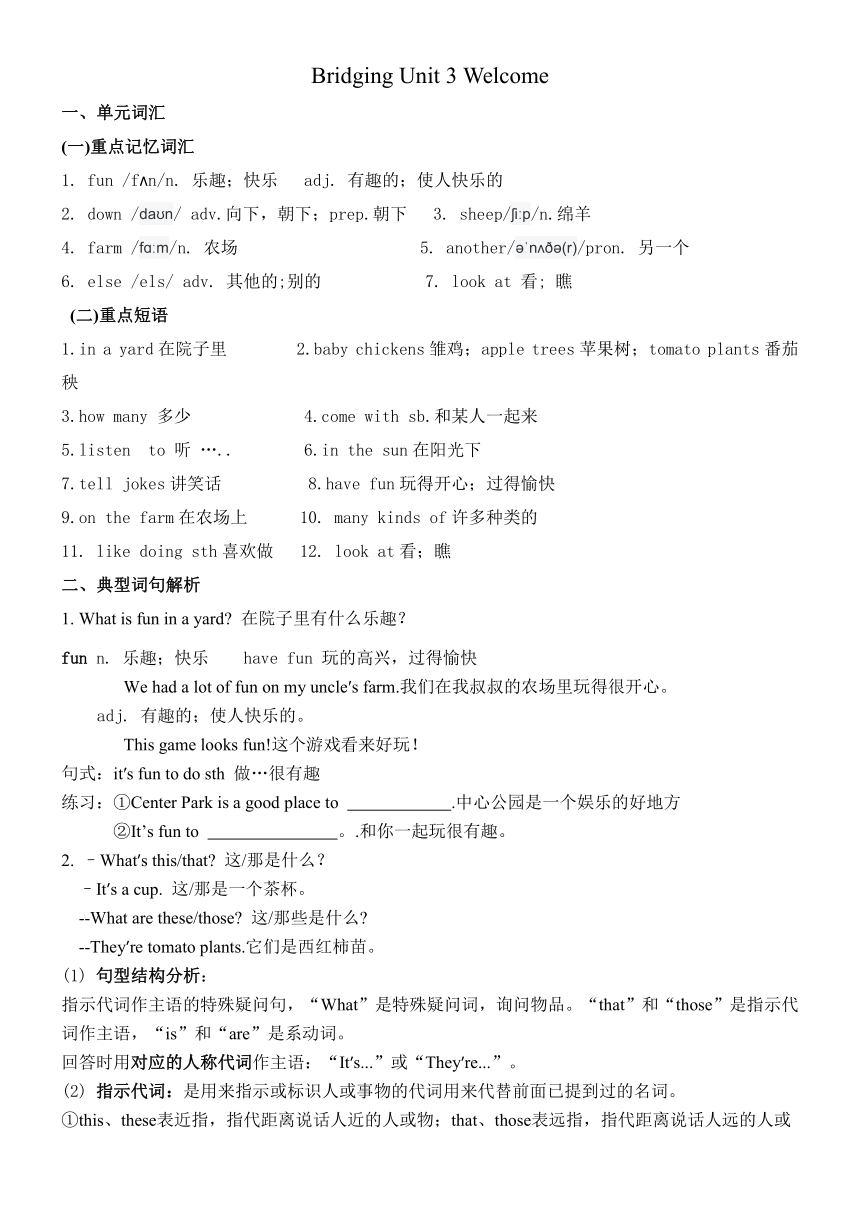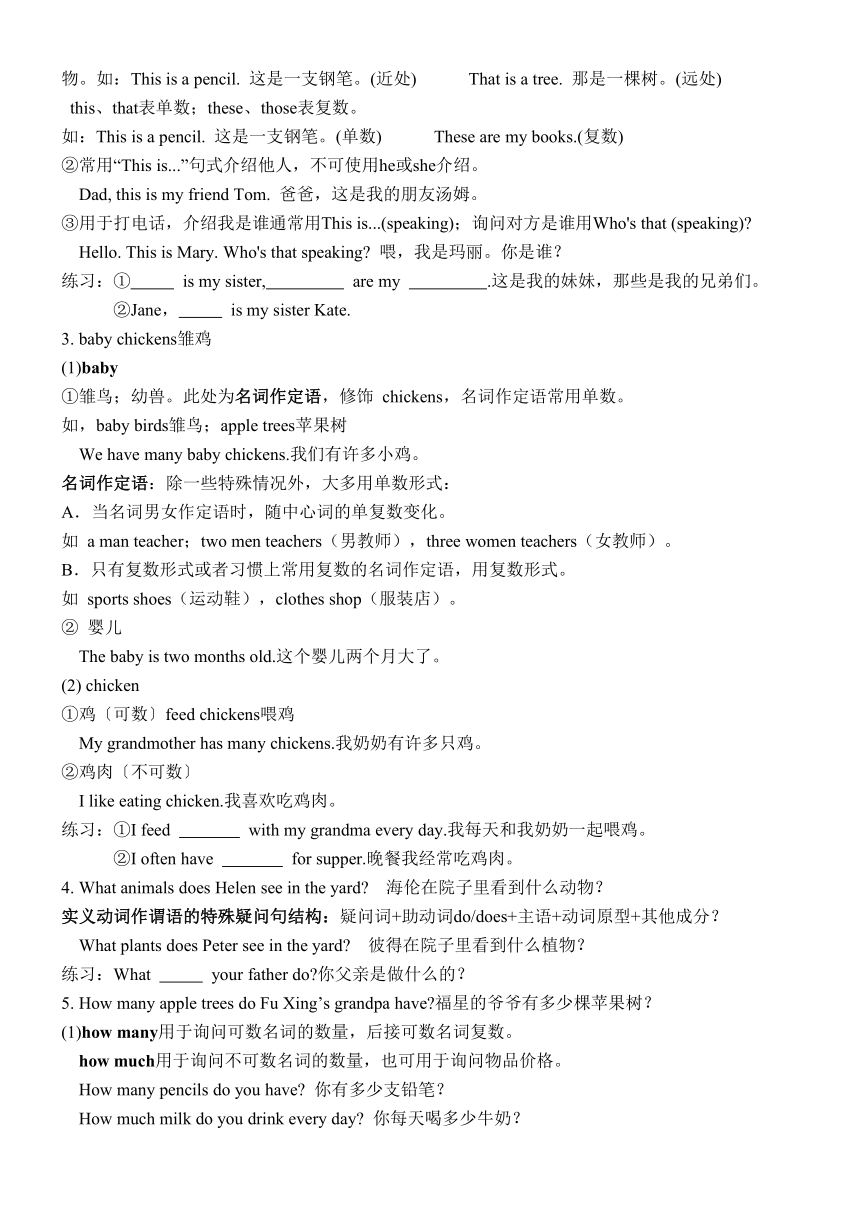Bridging Unit 3 Welcome单元知识讲义鲁教版英语六年级上册
文档属性
| 名称 | Bridging Unit 3 Welcome单元知识讲义鲁教版英语六年级上册 |  | |
| 格式 | docx | ||
| 文件大小 | 30.3KB | ||
| 资源类型 | 教案 | ||
| 版本资源 | 鲁教版 | ||
| 科目 | 英语 | ||
| 更新时间 | 2024-09-20 12:45:57 | ||
图片预览


文档简介
Bridging Unit 3 Welcome
一、单元词汇
(一)重点记忆词汇
1. fun /f n/n. 乐趣;快乐 adj. 有趣的;使人快乐的
2. down /da n/ adv.向下,朝下;prep.朝下 3. sheep/ i p/n.绵羊
4. farm /fɑ m/n. 农场 5. another/ n (r)/pron. 另一个
6. else /els/ adv. 其他的;别的 7. look at 看; 瞧
(二)重点短语
1.in a yard在院子里 2.baby chickens雏鸡;apple trees苹果树;tomato plants番茄秧
3.how many 多少 4.come with sb.和某人一起来
5.listen to 听 ….. 6.in the sun在阳光下
7.tell jokes讲笑话 8.have fun玩得开心;过得愉快
9.on the farm在农场上 10. many kinds of许多种类的
11. like doing sth喜欢做 12. look at看;瞧
二、典型词句解析
1. What is fun in a yard 在院子里有什么乐趣?
fun n. 乐趣;快乐 have fun 玩的高兴,过得愉快
We had a lot of fun on my uncle′s farm.我们在我叔叔的农场里玩得很开心。
adj. 有趣的;使人快乐的。
This game looks fun!这个游戏看来好玩!
句式:it′s fun to do sth 做…很有趣
练习:①Center Park is a good place to .中心公园是一个娱乐的好地方
②It’s fun to 。.和你一起玩很有趣。
2. –What′s this/that 这/那是什么?
–It′s a cup. 这/那是一个茶杯。
--What are these/those 这/那些是什么
--They′re tomato plants.它们是西红柿苗。
(1) 句型结构分析:
指示代词作主语的特殊疑问句,“What”是特殊疑问词,询问物品。“that”和“those”是指示代词作主语,“is”和“are”是系动词。
回答时用对应的人称代词作主语:“It′s...”或“They′re...”。
(2) 指示代词:是用来指示或标识人或事物的代词用来代替前面已提到过的名词。
①this、these表近指,指代距离说话人近的人或物;that、those表远指,指代距离说话人远的人或物。如:This is a pencil. 这是一支钢笔。(近处) That is a tree. 那是一棵树。(远处)
this、that表单数;these、those表复数。
如:This is a pencil. 这是一支钢笔。(单数) These are my books.(复数)
②常用“This is...”句式介绍他人,不可使用he或she介绍。
Dad, this is my friend Tom. 爸爸,这是我的朋友汤姆。
③用于打电话,介绍我是谁通常用This is...(speaking);询问对方是谁用Who's that (speaking)
Hello. This is Mary. Who's that speaking 喂,我是玛丽。你是谁?
练习:① is my sister, are my .这是我的妹妹,那些是我的兄弟们。
②Jane, is my sister Kate.
3. baby chickens雏鸡
(1)baby
①雏鸟;幼兽。此处为名词作定语,修饰 chickens,名词作定语常用单数。
如,baby birds雏鸟;apple trees苹果树
We have many baby chickens.我们有许多小鸡。
名词作定语:除一些特殊情况外,大多用单数形式:
A.当名词男女作定语时,随中心词的单复数变化。
如 a man teacher;two men teachers(男教师),three women teachers(女教师)。
B.只有复数形式或者习惯上常用复数的名词作定语,用复数形式。
如 sports shoes(运动鞋),clothes shop(服装店)。
② 婴儿
The baby is two months old.这个婴儿两个月大了。
(2) chicken
①鸡〔可数〕feed chickens喂鸡
My grandmother has many chickens.我奶奶有许多只鸡。
②鸡肉〔不可数〕
I like eating chicken.我喜欢吃鸡肉。
练习:①I feed with my grandma every day.我每天和我奶奶一起喂鸡。
②I often have for supper.晚餐我经常吃鸡肉。
4. What animals does Helen see in the yard 海伦在院子里看到什么动物?
实义动词作谓语的特殊疑问句结构:疑问词+助动词do/does+主语+动词原型+其他成分?
What plants does Peter see in the yard 彼得在院子里看到什么植物?
练习:What your father do 你父亲是做什么的?
5. How many apple trees do Fu Xing’s grandpa have 福星的爷爷有多少棵苹果树?
(1)how many用于询问可数名词的数量,后接可数名词复数。
how much用于询问不可数名词的数量,也可用于询问物品价格。
How many pencils do you have 你有多少支铅笔?
How much milk do you drink every day 你每天喝多少牛奶?
How much is the pen 这支钢笔多少钱?
(2) Fu Xing′s grandparents 名词所有格,意为“......的”。
名词所有格:通常有生命的名词所有格常用′s结构;表示时间、距离、价格的名词所有格也用′s结构,如 today′s news, ten minutes′ ride, 100 dollars′ worth。
一般情况直接加′s Kate′s room Father′s Day
以s结尾的复数名词,在其后加’ Teachers′ Day parents′ room
不以s结尾的复数名词,在其后加′s Children′s Day Women′s Day
主谓一致:表示两人共有的人或物时,只在最后加“′s”,按单数;表示两人各自拥有的人或物时,要在各自的词尾加“′s”,且被修饰的名词为复数,按复数。
Jim and Mike′s room 吉姆和迈克(共同)的房间
Jim’s and Mike′s rooms 吉姆和迈克(各自)的房间
练习:Tom and jim’s mother (be) a teacher.
6. Come with me and dog.
With“同…一起”,表伴随。
Our teacher often plays games with us.我们的老师经常和我们一起做游戏。
练习:I visited my grandparents my father last week.
7.We will listen to music.我们将要听音乐。
listen to 后接听的人或事物,表示在“倾听……的声音”。
Listen to me carefully!认真听我讲。
练习:Are you (listen) to me 你在听我说话吗
8. We will sit in the sun.我们会坐在阳光下
in the sun 在阳光下,“晒太阳”。
9. You can see many kinds of animals. 你可以看到许多种类的动物。
与kind搭配的短语:kind of有点儿,有几分(与种类词义无关)
a kind of一种;
kinds of多种多样的;
all kinds of各种各样的;
different kinds of不同种类的;
The zoo has many kinds of animals.动物园有许多种动物。
练习:①There are kinds of animals in the forest.森林里有许多种动物。
②You can play games there.你可以在那里玩不同的游戏
③We sell clothes.我们出售各种各样的衣服。
10. Do you like my uncle’s farm 你喜欢我叔叔的农场吗?
(1)句型“助动词+主语+like+其他成分?”询问某人的喜好,意为“......喜欢......吗?”
肯定回答用“Yes,主语+do/does.”;
否定回答用“No,主语+don’t/doesn't.”。
—Do you like apples 你喜欢苹果吗?
—Yes,I do. 是的,我喜欢。
—Does she like English 她喜欢英语吗?
—No,she doesn’t. 不,她不喜欢。
(2) like“喜欢;喜爱”。like to do和like doing都表示喜欢做某事
①like sth.喜欢某物 I like English.我喜欢英语。
②like to do sth.喜欢做某事 He likes to play computer games.他喜欢玩电脑游戏。
③like doing sth.喜欢做某事 They like playing football.他们喜欢踢足球。
练习: your PE teacher like (play) games with you.你们体育老师喜欢和你们做游戏吗?
11. Another duck is behind the big tree. 另一只鸭子在那棵大树后面。
(1)辨析another和the other
①the other 指“(两者中)另一个”,表特指。
常用句型:one…the other… 一个… 另一个…
He has two bikes. One is red, the other is black.他有两辆自行车,一辆红色的,一辆黑色的。
②another 指“三者或三者以上的另一个”, 后接单数名词。
固定搭配:another +数词+复数名词 = 数词+more+复数名词
如 another two minutes= two more minutes另外两分钟
I need another bottle. 我需要另一个瓶子。
(2) behind 在…后面;反义短语为:in front of(在…前面)。
There is a pool behind the house.房子后面有一个水池。
练习:—Where my bag?我的包在哪儿?
—It’s the door.在门后面。
12. Look at the cows.看那些奶牛。
(1) look at 看;瞧。后接名词或代词作宾语。
Look at the picture,please请看这张照片。
(2)辨析:look与 see
两者都有“看”的意思,但用法和意义不同:
Look 看,强调动作,不强调是否“看 见”,后接宾语时,常与介词at连用;
See 看到,强调结果,表示“看见,看到”。
Look!Here comes the bus.看!公共汽车来了。
Look at me carefully.仔细/认真看我。
I see many birds in the sky.我看见天上有许多鸟。
练习:Look the blackboard,you will something important.
类似:listen与hear
一、单元词汇
(一)重点记忆词汇
1. fun /f n/n. 乐趣;快乐 adj. 有趣的;使人快乐的
2. down /da n/ adv.向下,朝下;prep.朝下 3. sheep/ i p/n.绵羊
4. farm /fɑ m/n. 农场 5. another/ n (r)/pron. 另一个
6. else /els/ adv. 其他的;别的 7. look at 看; 瞧
(二)重点短语
1.in a yard在院子里 2.baby chickens雏鸡;apple trees苹果树;tomato plants番茄秧
3.how many 多少 4.come with sb.和某人一起来
5.listen to 听 ….. 6.in the sun在阳光下
7.tell jokes讲笑话 8.have fun玩得开心;过得愉快
9.on the farm在农场上 10. many kinds of许多种类的
11. like doing sth喜欢做 12. look at看;瞧
二、典型词句解析
1. What is fun in a yard 在院子里有什么乐趣?
fun n. 乐趣;快乐 have fun 玩的高兴,过得愉快
We had a lot of fun on my uncle′s farm.我们在我叔叔的农场里玩得很开心。
adj. 有趣的;使人快乐的。
This game looks fun!这个游戏看来好玩!
句式:it′s fun to do sth 做…很有趣
练习:①Center Park is a good place to .中心公园是一个娱乐的好地方
②It’s fun to 。.和你一起玩很有趣。
2. –What′s this/that 这/那是什么?
–It′s a cup. 这/那是一个茶杯。
--What are these/those 这/那些是什么
--They′re tomato plants.它们是西红柿苗。
(1) 句型结构分析:
指示代词作主语的特殊疑问句,“What”是特殊疑问词,询问物品。“that”和“those”是指示代词作主语,“is”和“are”是系动词。
回答时用对应的人称代词作主语:“It′s...”或“They′re...”。
(2) 指示代词:是用来指示或标识人或事物的代词用来代替前面已提到过的名词。
①this、these表近指,指代距离说话人近的人或物;that、those表远指,指代距离说话人远的人或物。如:This is a pencil. 这是一支钢笔。(近处) That is a tree. 那是一棵树。(远处)
this、that表单数;these、those表复数。
如:This is a pencil. 这是一支钢笔。(单数) These are my books.(复数)
②常用“This is...”句式介绍他人,不可使用he或she介绍。
Dad, this is my friend Tom. 爸爸,这是我的朋友汤姆。
③用于打电话,介绍我是谁通常用This is...(speaking);询问对方是谁用Who's that (speaking)
Hello. This is Mary. Who's that speaking 喂,我是玛丽。你是谁?
练习:① is my sister, are my .这是我的妹妹,那些是我的兄弟们。
②Jane, is my sister Kate.
3. baby chickens雏鸡
(1)baby
①雏鸟;幼兽。此处为名词作定语,修饰 chickens,名词作定语常用单数。
如,baby birds雏鸟;apple trees苹果树
We have many baby chickens.我们有许多小鸡。
名词作定语:除一些特殊情况外,大多用单数形式:
A.当名词男女作定语时,随中心词的单复数变化。
如 a man teacher;two men teachers(男教师),three women teachers(女教师)。
B.只有复数形式或者习惯上常用复数的名词作定语,用复数形式。
如 sports shoes(运动鞋),clothes shop(服装店)。
② 婴儿
The baby is two months old.这个婴儿两个月大了。
(2) chicken
①鸡〔可数〕feed chickens喂鸡
My grandmother has many chickens.我奶奶有许多只鸡。
②鸡肉〔不可数〕
I like eating chicken.我喜欢吃鸡肉。
练习:①I feed with my grandma every day.我每天和我奶奶一起喂鸡。
②I often have for supper.晚餐我经常吃鸡肉。
4. What animals does Helen see in the yard 海伦在院子里看到什么动物?
实义动词作谓语的特殊疑问句结构:疑问词+助动词do/does+主语+动词原型+其他成分?
What plants does Peter see in the yard 彼得在院子里看到什么植物?
练习:What your father do 你父亲是做什么的?
5. How many apple trees do Fu Xing’s grandpa have 福星的爷爷有多少棵苹果树?
(1)how many用于询问可数名词的数量,后接可数名词复数。
how much用于询问不可数名词的数量,也可用于询问物品价格。
How many pencils do you have 你有多少支铅笔?
How much milk do you drink every day 你每天喝多少牛奶?
How much is the pen 这支钢笔多少钱?
(2) Fu Xing′s grandparents 名词所有格,意为“......的”。
名词所有格:通常有生命的名词所有格常用′s结构;表示时间、距离、价格的名词所有格也用′s结构,如 today′s news, ten minutes′ ride, 100 dollars′ worth。
一般情况直接加′s Kate′s room Father′s Day
以s结尾的复数名词,在其后加’ Teachers′ Day parents′ room
不以s结尾的复数名词,在其后加′s Children′s Day Women′s Day
主谓一致:表示两人共有的人或物时,只在最后加“′s”,按单数;表示两人各自拥有的人或物时,要在各自的词尾加“′s”,且被修饰的名词为复数,按复数。
Jim and Mike′s room 吉姆和迈克(共同)的房间
Jim’s and Mike′s rooms 吉姆和迈克(各自)的房间
练习:Tom and jim’s mother (be) a teacher.
6. Come with me and dog.
With“同…一起”,表伴随。
Our teacher often plays games with us.我们的老师经常和我们一起做游戏。
练习:I visited my grandparents my father last week.
7.We will listen to music.我们将要听音乐。
listen to 后接听的人或事物,表示在“倾听……的声音”。
Listen to me carefully!认真听我讲。
练习:Are you (listen) to me 你在听我说话吗
8. We will sit in the sun.我们会坐在阳光下
in the sun 在阳光下,“晒太阳”。
9. You can see many kinds of animals. 你可以看到许多种类的动物。
与kind搭配的短语:kind of有点儿,有几分(与种类词义无关)
a kind of一种;
kinds of多种多样的;
all kinds of各种各样的;
different kinds of不同种类的;
The zoo has many kinds of animals.动物园有许多种动物。
练习:①There are kinds of animals in the forest.森林里有许多种动物。
②You can play games there.你可以在那里玩不同的游戏
③We sell clothes.我们出售各种各样的衣服。
10. Do you like my uncle’s farm 你喜欢我叔叔的农场吗?
(1)句型“助动词+主语+like+其他成分?”询问某人的喜好,意为“......喜欢......吗?”
肯定回答用“Yes,主语+do/does.”;
否定回答用“No,主语+don’t/doesn't.”。
—Do you like apples 你喜欢苹果吗?
—Yes,I do. 是的,我喜欢。
—Does she like English 她喜欢英语吗?
—No,she doesn’t. 不,她不喜欢。
(2) like“喜欢;喜爱”。like to do和like doing都表示喜欢做某事
①like sth.喜欢某物 I like English.我喜欢英语。
②like to do sth.喜欢做某事 He likes to play computer games.他喜欢玩电脑游戏。
③like doing sth.喜欢做某事 They like playing football.他们喜欢踢足球。
练习: your PE teacher like (play) games with you.你们体育老师喜欢和你们做游戏吗?
11. Another duck is behind the big tree. 另一只鸭子在那棵大树后面。
(1)辨析another和the other
①the other 指“(两者中)另一个”,表特指。
常用句型:one…the other… 一个… 另一个…
He has two bikes. One is red, the other is black.他有两辆自行车,一辆红色的,一辆黑色的。
②another 指“三者或三者以上的另一个”, 后接单数名词。
固定搭配:another +数词+复数名词 = 数词+more+复数名词
如 another two minutes= two more minutes另外两分钟
I need another bottle. 我需要另一个瓶子。
(2) behind 在…后面;反义短语为:in front of(在…前面)。
There is a pool behind the house.房子后面有一个水池。
练习:—Where my bag?我的包在哪儿?
—It’s the door.在门后面。
12. Look at the cows.看那些奶牛。
(1) look at 看;瞧。后接名词或代词作宾语。
Look at the picture,please请看这张照片。
(2)辨析:look与 see
两者都有“看”的意思,但用法和意义不同:
Look 看,强调动作,不强调是否“看 见”,后接宾语时,常与介词at连用;
See 看到,强调结果,表示“看见,看到”。
Look!Here comes the bus.看!公共汽车来了。
Look at me carefully.仔细/认真看我。
I see many birds in the sky.我看见天上有许多鸟。
练习:Look the blackboard,you will something important.
类似:listen与hear
同课章节目录
